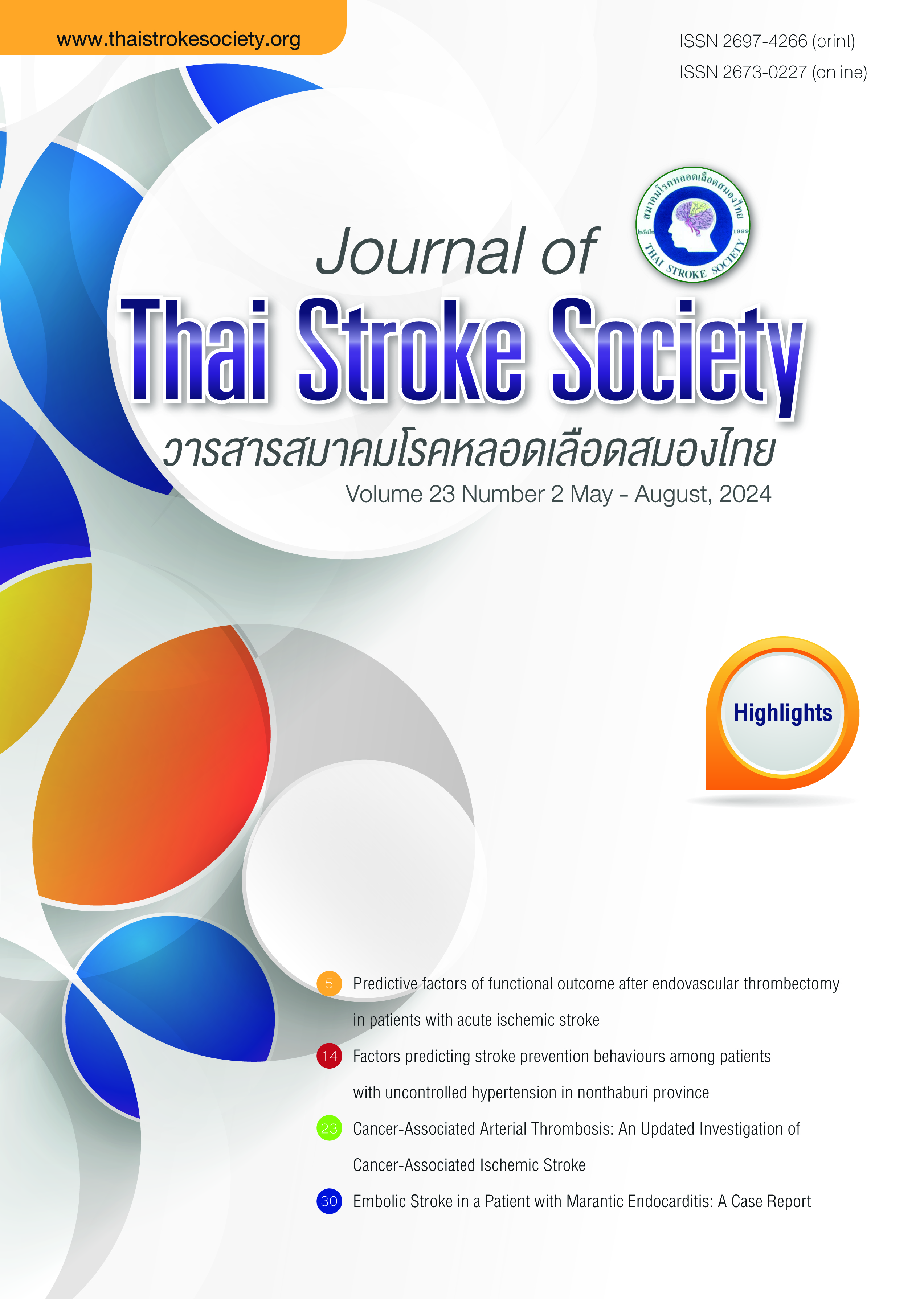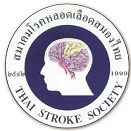Predictive factors of functional outcome after endovascular thrombectomy in patients with acute ischemic stroke
Keywords:
Functional Recovery, Endovascular Thrombectomy, Acute Ischemic StrokeAbstract
Background: Functional recovery plays a crucial role in helping patients to their normal or nearly normal state after treatment and enabling them to resume their daily activities.
Objectives: This study aimed to investigate the process of functional recovery following endovascular thrombectomy and identify predictive factors which associated with the recovery process.
Methods: A purposive sample comprising of 79 patients who underwent endovascular thrombectomy was included in this study. Descriptive statistics and stepwise multiple regression analyses were employed to analyze the collected data.
Results: Functional recovery of post-thrombectomy patients were at severe dependency level. Their median ± IQR of Bathel index was 36.5±31.5. The combination of stroke severity and disability level explained 65 percent of the variabilities in predicting functional recovery (R2 = 0.65, p = 0.05)
Conclusion: These findings provide valuable insights into the nursing care of acute ischemic stroke patients undergoing endovascular thrombectomy and emphasizing continuity of stroke care.
References
Feigin VL, Brainin M, Norrving B, Martins S, Sacco RL, Hacke W, et al. World Stroke Organization (WSO): global stroke fact sheet 2022. International Journal of Stroke 2020;17(1):18-29.
อรรถเกียรติกาญจนพิบูลวงศ์, ภาณุวัฒน์ คำวังสง่า, สุธิดา แก้วทา. รายงานสถานการณ์โรคNCDs เบาหวาน ความดันโลหิตสูง และปัจจัยเสี่ยงที่เกี่ยวข้อง พ.ศ. 2562. สำนักพิมพ์อักษรกราฟฟิคแอนด์ดีไซน์ 2563;9-14.
สมศักดิ์ เทียมเก่า. สถานการณ์โรคหลอดเลือดสมอง. วารสารประสาทวิทยาแห่งประเทศไทย 2564; 37(4):54-60.
จันทร์จิรา สีสว่าง, ปุลวิชช์ ทองแตง. ปัจจัยที่เกี่ยวข้องกับความสามารถในการจัดการตนเองของผู้สูงอายุโรคความดันโลหิตสูงในเอเชีย: การทบทวนวิจัยเชิงคุณภาพอย่างเป็นระบบ. Nursing Science Journal of Thailand 2562;37(1):86-107.
Nambiar V, Sohn SI, Almekhlafi MA, Chang HW, Mishra S, Qazi E, et al. CTA collateral status and response to recanalization in patients with acute ischemic stroke. American Journal of Neuroradiology 2014;35:884-90.
Turc, Guillaume, et al. European stroke organization (ESO)–European Society for minimally invasive neurological therapy (ESMINT) guidelines on mechanical thrombectomy in acute ischaemic stroke Endorsed by stroke Alliance for Europe (SAFE)." European stroke journal 4.1 2019;6-12.
Wahlgren N, MoreiraT, MichelP. et al. Mechanical thrombectomy in acute ischemic stroke: consensus statement by ESO-Karolinska stroke update2014/2015, supported by ESO, ESMINT, ESNRand EAN. International Journal of Stroke 2016;11:134-47.
Powers WJ, Derdeyn CP, Biller J, et al. 2015. American Heart Association/American Stroke Association-focused update of the 2013 guidelines for the early management of patients with acute ischemic stroke regarding endovascular treatment: a guideline for healthcare professionals from the American Heart Association/American Stroke Association. Stroke 2015;46:3020-35.
พรภัทร ธรรมสโรช, ดิษยา รัตนากร, สามารถ นิธินันทน์, ศิรินธรา สิงหรา ณ อยุธยา, อัญชลี ชูโรจน์, สุรีรัตน์ สุวัชรังกูรและคณะ. แนวทางการรักษาของประเทศไทยสำหรับผู้ป่วยโรคหลอดเลือดสมองขาดเลือดระยะเฉียบพลันโดยการรักษาผ่านสายสวนหลอดเลือด พ.ศ. 2562. วารสารโรคหลอดเลือดสมองไทย 2562;18(2):52-75.
Goyal, Mayank, et al. Randomized assessment of rapid endovascular treatment of ischemic stroke. New England Journal of Medicine 2015;1019-30.
Campbell BC, Mitchell PJ, Kleinig TJ, et al. Endovascular therapy for ischemic stroke with perfusion-imaging selection. New England Journal of Medicine 2015;372:1009-18.
Yoshimura S, Sakai N, Yamagami H, Uchida K, Beppu M, Toyoda K. Endovascular therapy for acute stroke with a large ischemic region. New England Journal of Medicine 2022;386(14):1303-13.
พรภัทร ธรรมสโรช. Endovascular Treatment in Patients with Acute Ischemic Stroke. วารสารสมาคมโรคหลอดเลือดสมองไทย 2558;14(3):124-34.
ปรีดา อารยาวิชานนท์. การฟื้นฟูผู้ป่วยโรคหลอดเลือดสมอง. สรรพสิทธิเวชสาร 2559;37(1-3):43-58.
อวยพร จงสกุล, ศิริพร สีสันต์, กัญญา เลี่ยนเครือ, ศิริกุล การุณเจริญพาณิชย์. รูปแบบการจัดการ การดูแลผู้ป่วยหลอดเลือดสมองเพื่อฟื้นฟูความสามารถในการปฏิบัติกิจวัตรประจำวันโรงพยาบาลพหลพลพยุหเสนา. วารสารแพทย์เขต 4-5 2563;39(3):454-471.
Kauffmann J, Grun D, Yilmaz U, Wagenpfeik G, Fabbender K, Fousse M. et al. Randomized assessment of rapid endovascular treatment of ischemic stroke. New England Journal of Medicine 2015;372:1019-30.
Junttola U, Lahtinen S, Liisanantti J, Vakkala M, Kaakinen T, Isokangas JM. Medical complications and outcome after endovascular therapy for acute ischemic stroke. Acta Neurological Scandinavica 2021;144(6):623-31.
Neuman B, Fawcett J. The Neuman systems model. 4th ed. Upper Saddle River, NJ: Prentice Hall; 2002.
Shi K., Tian DC, Li ZG, Ducruet AF, Lawton MT, Shi FD. Global brain inflammation in stroke. The Lancet Neurology 2019;18(11):1058-66.
Jagoda AS, Bazarian JJ, Bruns JJ. Cantrill S., Gean AD, Howard PK. Clinical policy: neuroimaging and decision making in adult mild traumatic brain injury in the acute setting. Journal of Emergency Nursing 2009;35(2):e5-e40.
Korn A, Golan H, Melamed I, Pascual-Marqui R, Friedman A. Focal cortical dysfunction and blood-brain barrier disruption in patients with post-concussion syndrome. Journal of Clinical Neurophysiology 2005;22(1):1-9.
ฉัตรกมล ประจวบลาภ. ภาวะความดันในกะโหลกศีรษะสูงในผู้ป่วยที่มีพยาธิสภาพที่สมอง : มิติของการพยาบาลตามหลักฐานเชิงประจักษ์. วารสารสภาการพยาบาล 2561;33(2):15-28.
Downloads
Published
How to Cite
Issue
Section
License
Copyright (c) 2024 Journal of Thai Stroke Society

This work is licensed under a Creative Commons Attribution-NonCommercial-NoDerivatives 4.0 International License.
ข้อความภายในบทความที่ตีพิมพ์ในวารสารสมาคมโรคหลอดเลือดสมองไทยเล่มนี้ ตลอดจนความรับผิดชอบด้านเนื้อหาและการตรวจร่างบทความเป็นของผู้นิพนธ์ ไม่เกี่ยวข้องกับกองบรรณาธิการแต่อย่างใด การนำเนื้อหา ข้อความหรือข้อคิดเห็นของบทความไปเผยแพร่ ต้องได้รับอนุญาตจากกองบรรณาธิการอย่างเป็นลายลักษณ์อักษร ผลงานที่ได้รับการตีพิมพ์ในวารสารเล่มนี้ถือเป็นลิขสิทธิ์ของวารสาร





